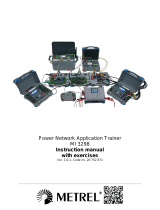
Due to poor sealing, moisture or moisture may enter the action counter during operation, which
will rust the internal components and cause the counter to not operate normally. Therefore, the
"Regulations" stipulates that it should be inspected once a year. The methods to check the
operation of the counter on site include capacitor discharge current branch, AC method and
standard impulse current method. Research shows that the standard impulse current method is
the most reliable, and its principle wiring is shown in Figure 2.
The 8/20μs, 100A impulse current wave generated by the impulse current generator is applied
to the action counter. If the counter operates normally, the instrument is in good condition,
otherwise it should be disassembled and repaired. For example, a certain electric power bureau
used this method to detect 27 counters, of which 3 did not move, and the disassembly found
that the internal components were damp and damaged.
The "Regulations" stipulate that the continuous test should be performed 3 to 5 times, and the
normal action should be performed each time, and the time interval between each time should
not be less than 30s. The recorder should be adjusted to 0 after the test.
Figure 2 Principle wiring of standard impulse current detection method
(The dashed box is the impulse current generator)
C-charging capacitor JR-charging resistance L-damping inductance
D-silicon rectifier diode r-shunt; B-test transformer;
V electrostatic voltmeter CRO high voltage oscilloscope
3.3 Operation Method
1. Connect the output end of the instrument to the two ends of the arrester counter (the
connecting wire should be as short as possible), the red end is connected to the upper end, and
the black end is grounded.
2. After connecting the power cord, check whether the instrument and wiring are correct, and
then start the test after confirming that it is correct.
3. Turn on the power switch (the power light is on), and after the meter is charged to 600V or
more, you can start the calibration.
4. Press the impact test button, the output voltage will drop immediately, at this time you can
observe the action of the counter Condition.
5. If multiple tests are required, when the output voltage reaches 600V or more, press the
impact test button again and observe the action of the counter.
6. After the inspection is completed, immediately turn off the power supply, and then remove the
wiring when the output voltage has completely returned to zero.










